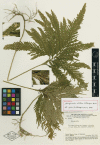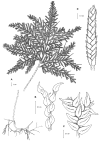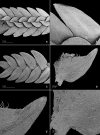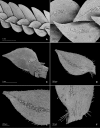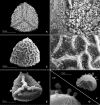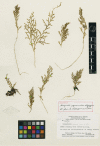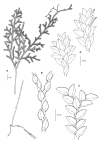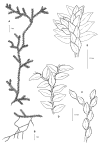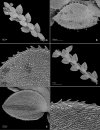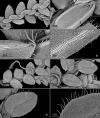Novel fern- and centipede-like Selaginella (Selaginellaceae) species and a new combination from South America - PubMed (original) (raw)
Novel fern- and centipede-like Selaginella (Selaginellaceae) species and a new combination from South America
Iván A Valdespino. PhytoKeys. 2017.
Abstract
Two new Selaginella species (i.e. S. altheae Valdespino and S. squamulosa Valdespino) and a novel combination [i.e. S. philipsonii (Jermy & Rankin) Valdespino] from South America are proposed. Descriptions, illustrations (line drawings and scanning electron micrographs, SEM, images), discussion on taxonomic affinities and information on habitat, distribution and phenology, as well as on conservation status are provided for each. Selaginella altheae is morphologically similar to species with erect, fern-like habit placed in the "Selaginella flabellata (L.) Spring group" as defined by Hieronymus, while S. squamulosa is allied to a species assembly with centipede-like habit here informally termed the "Selaginella vernicosa Baker group;" whereas S. philipsonii with its moss-like habit may be associated with species in the "Selaginella jungermannioides (Gaudich.) Spring group" or those centered on S. ovifolia Baker. All taxa here proposed are classified in subg. Stachygynandrum.
ResumenDos nuevas especies de Selaginella (i.e., S. altheae Valdespino y S. squamulosa Valdespino) y una nueva combinación [i.e., S. philipsonii (Jermy & Rankin) Valdespino de Sur América son propuestas. Para cada una de ellas se provee una descripción, ilustraciones (i.e. dibujos y micrografías de microscopio electrónico de barrido, MEB), discusión sobre su afinidad taxonómica, información sobre su hábitat, distribución y fenología, así como su estado de conservación. Selaginella altheae es morfológicamente similar a las especies con hábito erecto y parecidas a los helechos que se incluyen en el “grupo de Selaginella flabellata (L.) Spring” como fue definido por Hieronymus; S. squamulosa es afín a especies con hábito centipediforme que aquí informalmente se denominan “grupo de Selaginella vernicosa Baker”, mientras que S. philipsonii con su hábito parecido al de los musgos puede estar emparentada con el “grupo de Selaginella jungermannioides (Gaudich.) Spring” o a las especies similares a S. ovifolia Baker. Por último, todos los taxa aquí propuestos se clasifican en el subg. Stachygynandrum.
Keywords: Amazon basin; Cuenca del Amazonas; Escudo guyanés; Guiana Highlands; New World; Nuevo Mundo; monomorphic; monomórficas; subgenera; subgéneros; tepuis; tepuyes.
Figures
Figure 1.
Selaginella altheae Valdespino. A Habit, upper surface of stem B Close up of section of the upper surface of the stem C Habit, lower surface of stem D Close up of section of the lower surface of the stem. A–D digitized images of holotype, Maguire et al. 60249 (NY).
Figure 2.
Selaginella altheae Valdespino. A Habit B Section of main stem above first branch showing median leaves, upper surface C Section of main stem above first branch showing lateral leaves and axillary leaf, lower surface D Close-up of strobilus. A–D line drawings of holotype, Maguire et al. 60249 (NY). Illustration made by Rubén Lozano.
Figure 3.
Selaginella altheae Valdespino. A Section of upper surface of stem branch B Close-up of lateral leaf from stem branch, upper surface C Section of lower surface of stem branch D Close-up of lateral leaf (from branch), lower surface E Close-up of distal portion and apex of lateral leaf, lower surface (same leaf shown in B); note, elongate and papillate idioblasts (a) and stomata along midrib (b) F Close-up of proximal (basal) portion of lateral leaf, lower surface (same leaf shown in B); note, elongate and papillate idioblasts (a) and stomata along midrib (b). A–F taken from holotype, Maguire et al. 60249 (NY).
Figure 4.
Selaginella altheae Valdespino. A Section of upper surface of stem branch showing median and lateral leaves B Close-up of median leaves from stem branch, upper surfaces C Close-up of median leaf from stem branch, lower surface D Close-up of median leaf from stem branch, upper surface E Close-up of distal portion and apex of median leaf, upper surface (same leaf shown in D); note, punctate to shortly elongate and papillate idioblasts (a) and stomata (b) along midrib F Close-up of proximal portion and base of median leaf, lower surface (same leaf shown in D); note, punctate to shortly elongate and papillate idioblasts (a), stomata (b) along midrib and submarginal and marginal portion near outer base and long cilia (c) on outer base. A–F taken from holotype, Maguire et al. 60249 (NY).
Figure 5.
Selaginella altheae Valdespino. A Megaspore, proximal face B Close-up of megaspore, proximal face C Megaspore, distal face D Close-up of megaspore, distal face E Microspore, proximal face F Microspore, distal-equatorial-proximal faces G Close-up of microspore, distal-equatorial faces; note, capitate projections and echinulate microstructure. A–G taken from holotype, Maguire et al. 60249 (NY).
Figure 6.
Selaginella squamulosa Valdespino. Holotype, Steyermark 103872 (NY).
Figure 7.
Selaginella squamulosa Valdespino. A Habit B Upper surface of stem showing median leaves C Lower surface of stem showing lateral leaves and axillary leaf D Close-up of strobili (apices of branches), upper surface. A–D line drawings of holotype, Steyermark 103872 (NY). Illustration made by Rubén Lozano.
Figure 8.
Selaginella squamulosa Valdespino. A–B Habit C Upper surface of stem showing median leaves D Lower surface of stem showing lateral leaves and axillary leaf E Close-up of distal portion of stem, upper surface. A–E line drawings of paratype, Boom et al. 6011 (NY). Illustration made by Rubén Lozano.
Figure 9.
Selaginella squamulosa Valdespino. A Section of upper surface of stem B Close-up of median leaf, upper surface; note, elongate, idioblast-like marginal cells on inner margin and submarginal and marginal stomata (a) along proximal ½ of outer margin and hairs (b) on lamina surface C Close-up of mid-distal portion of median leaf, upper surface (same leaf shown in B); note, elongate, idioblast-like marginal cells on inner margin, papillae on each cell lumen and hairs (b) on lamina surface D Section of lower surface of stem E Close-up of lateral leaf, lower surface F Close-up of section of acroscopic half of lateral leaf; note, papillae on cells lumen and marginal, idioblast-like and papillate cells. A–F taken from paratype, Boom et al. 6011 (NY).
Figure 10.
Selaginella squamulosa Valdespino. A Megaspore, proximal face B Close-up of megaspore, proximal face C Megaspore, distal face D Close-up of megaspore, distal face. A–D taken from paratype, Boom et al. 6011 (NY).
Figure 11.
Selaginella philipsonii (Jermy & Rankin) Valdespino. A Section of upper surface of stem showing median and lateral leaves B Close-up of median leaf, upper surfaces; note, inner margin and submarginal portion of outer margin composed of elongate, idioblast-like and papillate cells and stomata (a) along outer margin C Close-up of median leaf distal portion, upper surface; note, apex tipped by long, divergent cilia, cells with papillae and stomata along outer margin D Close-up of median leaf, upper surface; note, marginal stomata (a), submarginal portion of outer margin composed of elongate, idioblast-like and papillate cells and lumen of lamina cells with multiple papillae E Section of lower surface of stem showing lateral leaves, outer halves of median leaves and rhizophore F Close-up of (E) G Close-up of lateral leaf, lower surface (one of the leaf shown in E) H Close-up of lateral leaf, lower surface (same leaf shown in G); note, stomata along midrib, elongate, idioblast-like and papillate cells and long cilia along acroscopic margin. A–H taken from Steyermark & Rabe 96652 (GH).
Similar articles
- Taxonomic innovations in South American Selaginella (Selaginellaceae, Lycopodiophyta): description of five new species and an additional range extension.
Valdespino IA. Valdespino IA. PhytoKeys. 2020 Sep 4;159:71-113. doi: 10.3897/phytokeys.159.55330. eCollection 2020. PhytoKeys. 2020. PMID: 32973390 Free PMC article. - A taxonomic revision of the genus Selaginella (Selaginellaceae) from Nepal.
Shalimov AP, Wu YD, Zhang XC. Shalimov AP, et al. PhytoKeys. 2019 Oct 7;133:1-76. doi: 10.3897/phytokeys.133.37773. eCollection 2019. PhytoKeys. 2019. PMID: 31632179 Free PMC article. - Insights on the neuromodulatory propensity of Selaginella (Sanjeevani) and its potential pharmacological applications.
Chandran G, Muralidhara. Chandran G, et al. CNS Neurol Disord Drug Targets. 2014 Feb;13(1):82-95. doi: 10.2174/18715273113126660188. CNS Neurol Disord Drug Targets. 2014. PMID: 24152330 Review. - Taxonomic review of New World Tachyina (Coleoptera, Carabidae): descriptions of new genera, subgenera, and species, with an updated key to the subtribe in the Americas.
Boyd OF, Erwin TL. Boyd OF, et al. Zookeys. 2016 Oct 20;(626):87-123. doi: 10.3897/zookeys.626.10033. eCollection 2016. Zookeys. 2016. PMID: 27833435 Free PMC article. Review.
Cited by
- Phylogeny, character evolution, and classification of Selaginellaceae (lycophytes).
Zhou XM, Zhang LB. Zhou XM, et al. Plant Divers. 2023 Jul 20;45(6):630-684. doi: 10.1016/j.pld.2023.07.003. eCollection 2023 Nov. Plant Divers. 2023. PMID: 38197007 Free PMC article. - Taxonomic innovations in South American Selaginella (Selaginellaceae, Lycopodiophyta): description of five new species and an additional range extension.
Valdespino IA. Valdespino IA. PhytoKeys. 2020 Sep 4;159:71-113. doi: 10.3897/phytokeys.159.55330. eCollection 2020. PhytoKeys. 2020. PMID: 32973390 Free PMC article.
References
- Alston AHG. (1955) The heterophyllous Selaginellae of continental North America. Bulletin of the British Museum (Natural History), Botany 1: 219–274.
- Alston AHG, Jermy AC, Rankin JM. (1981) The genus Selaginella in tropical South America. Bulletin of the British Museum (Natural History), Botany 9: 233–330.
- Barbosa-Silva RG, Labiak PH, Gil ASB, Goldenberg R, Michelangeli FA, Martinelli G, Coelho MAN, Zappi DC, Forzza RC. (2016) Over the hills and far away: New plant records for the Guayana Shield in Brazil. Brittonia 68: 397–408. https://doi.org/10.1007/s12228-016-9435-3 - DOI
- Buck WR. (1978) The taxonomic status of Selaginella eatonii. American Fern Journal 68: 33–36. https://doi.org/10.2307/1546776 - DOI
- Buck WR, Lucanski TW. (1976) An anatomical and morphological comparison of Selaginella apoda and Selaginella ludoviciana. Bulletin of the Torrey Botanical Club 103: 9–16. https://doi.org/10.2307/2484743 - DOI
Grants and funding
University of Panama, Sistema Nacional de Investigación (SNI), Panamá
LinkOut - more resources
Full Text Sources
Other Literature Sources
